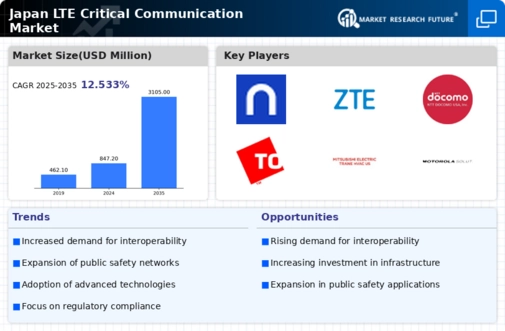Collaboration Among Stakeholders
Collaboration among various stakeholders, including government agencies, private companies, and research institutions, is emerging as a vital driver for the LTE Critical-Communication Market. Joint initiatives aimed at developing standardized communication protocols and interoperability solutions are gaining momentum. Such collaborations facilitate knowledge sharing and resource pooling, which are essential for advancing communication technologies. The establishment of public-private partnerships is expected to enhance innovation and accelerate the deployment of lte solutions across emergency services. This collaborative approach is likely to contribute to a projected market growth of 18% over the next few years.
Increased Focus on Cybersecurity
As the reliance on digital communication systems grows, so does the emphasis on cybersecurity within the LTE Critical-Communication Market. Japan's critical infrastructure is increasingly vulnerable to cyber threats, prompting government and private sector initiatives to enhance security measures. Investments in cybersecurity solutions are projected to rise by 20% annually, reflecting the urgent need to protect sensitive communication networks. This focus on cybersecurity not only safeguards communication systems but also instills confidence among users, thereby promoting the adoption of lte technologies in critical communication scenarios.
Government Support for Emergency Services
The Japanese government actively promotes the enhancement of emergency services, which significantly influences the LTE Critical-Communication Market. Initiatives aimed at improving disaster response capabilities have led to increased funding and resources allocated to critical communication systems. For instance, the government has invested approximately ¥100 billion in upgrading communication infrastructure to ensure seamless connectivity during emergencies. This support not only bolsters the capabilities of first responders but also encourages private sector investment in innovative communication technologies. As a result, the lte critical-communication market is expected to grow at a CAGR of 15% over the next five years, driven by the need for reliable communication in crisis situations.
Rising Demand for Public Safety Solutions
There is a growing demand for advanced public safety solutions in Japan, which is a key driver for the LTE Critical-Communication Market. With urbanization and population density increasing, the need for effective communication systems among emergency services has become paramount. The market is projected to reach ¥200 billion by 2026, reflecting a robust growth trajectory. This demand is fueled by the necessity for real-time data sharing and coordination among various agencies during emergencies. Consequently, stakeholders are investing in lte technology to enhance situational awareness and response times, thereby improving overall public safety.
Technological Advancements in Communication
Technological advancements play a crucial role in shaping the LTE Critical-Communication Market. Innovations such as 5G technology and enhanced data analytics capabilities are transforming how emergency services operate. These advancements enable faster data transmission and improved connectivity, which are essential for effective communication during critical situations. The integration of AI and machine learning into communication systems is also gaining traction, allowing for predictive analytics and better resource allocation. As these technologies continue to evolve, they are expected to drive the lte critical-communication market forward, with an anticipated market value of ¥250 billion by 2027.
























Leave a Comment